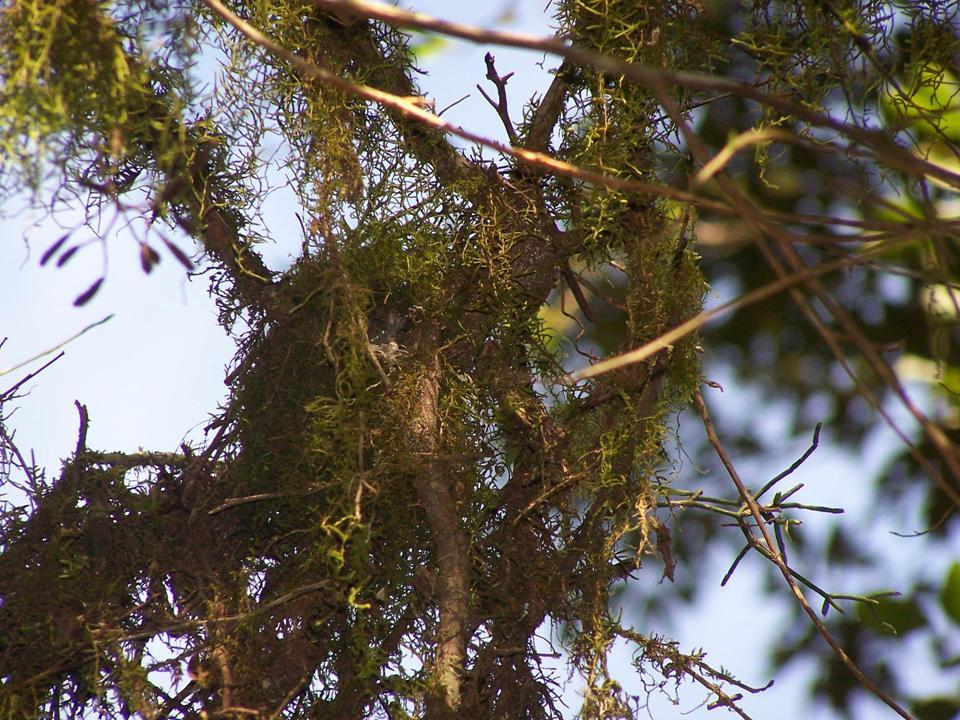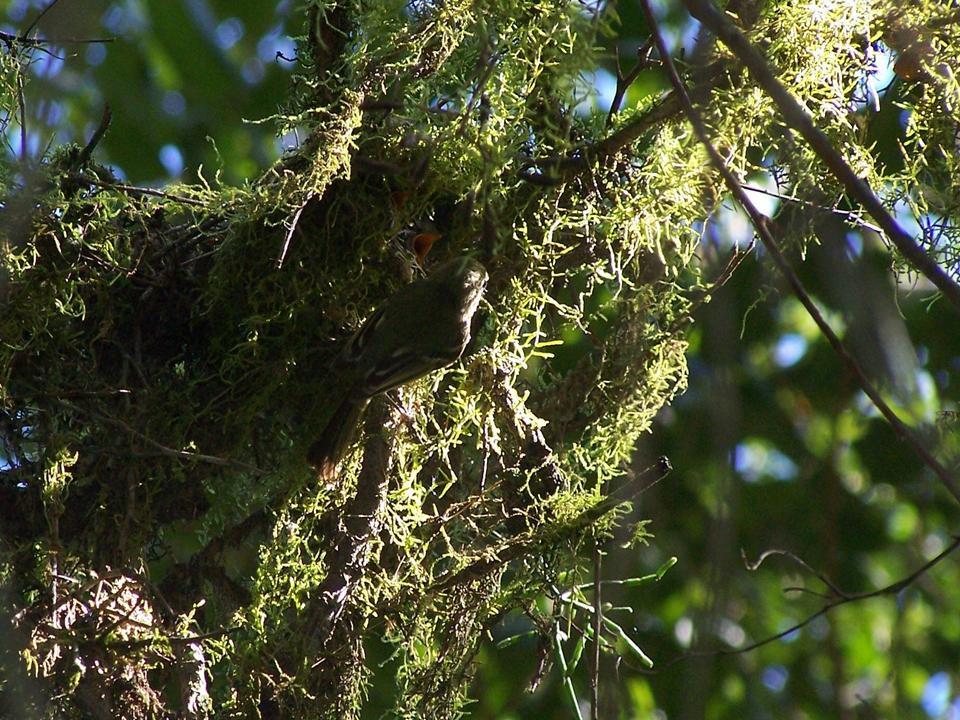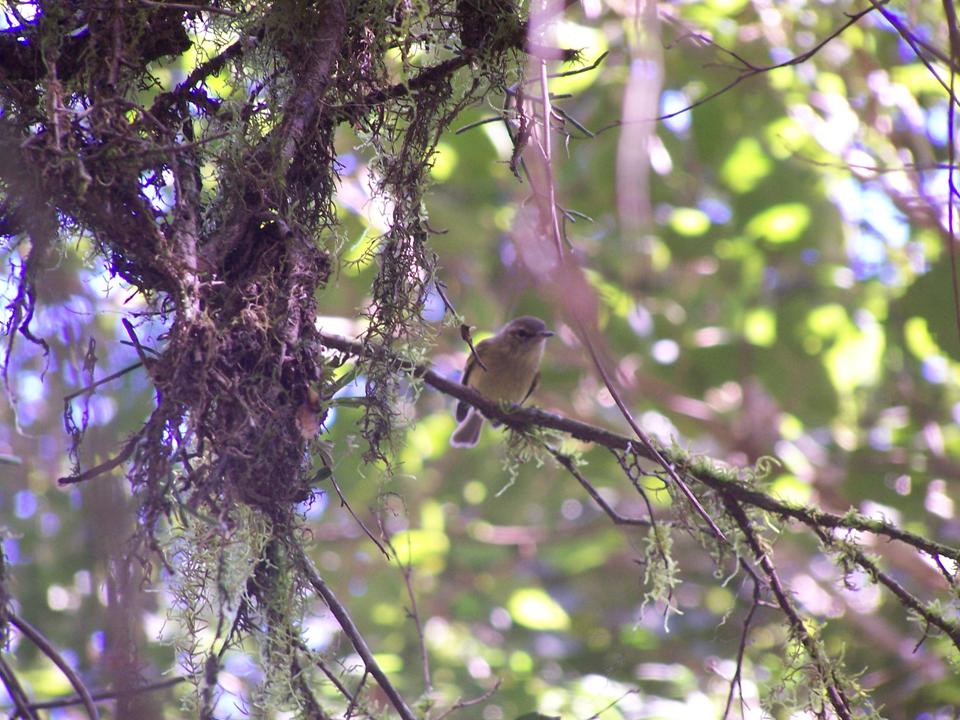

OBSERVATIONS AT A NEST OF MOTTLE-CHEEKED TYRANNULET Phylloscartes ventralis AT HOTEL TIROL, DEPARTAMENTO ITAPÚA, SOUTHERN PARAGUAY
Paul Smith and Adam Betuel
ABSTRACT - We provide details of three days of observations at an active nest of Mottle-cheeked Tyrannulet Phylloscartes ventralis from southern Paraguay. Details of parental care behaviour for the nearly fledged young are provided. Possible adaptations towards crypticity in the breeding cycle of this species are discussed. Comparisons are made with documented accounts of the breeding behaviour of this species in other countries. This represents the first documentation of breeding behaviour of this species in Paraguay.
INTRODUCTION
The nominate subspecies of the Mottle-cheeked Tyrannulet occurs in humid forests of south-eastern South America from southern Brazil and Uruguay west through northern Argentina and eastern Paraguay (Ridgely and Tudor 1994). In Paraguay it is an uncommon resident of the Atlantic forest canopy in the Alto Paraná region, becoming gradually scarcer towards the west and north (Clay and del Castillo 2004, del Castillo 2006). Though superficially similar to several other small sympatric forest tyrants (eg Yellow-olive Flycatcher Tolmomyias sulphurescens, Greenish Tyrannulet Phyllomyias virescens etc) it can be reliably identified on account of conspicuous broad pale spots at the tips of the tertials (Clay et al 1998) - see FIG 2.
FIG 1: Nest after departure of the young, showing camouflage and rounded entrance (Photo Paul Smith)
FIG 2: Adult feeding begging young at nest, note tertial spots (Photo Paul Smith)
NEST (FIG 1)
On 28 August 2006 an active nest of this species was located at Hotel Tirol (27o11’S, 55o47´W), Capitán Miranda, Departamento Itapúa, southern Paraguay. The nest contained two near-fledged juveniles and was watched for a total of 9 hours and 40 minutes over three days (covering hours 8-12am and 1.20-5.30pm) until the departure of the fledglings on 30 August 2006. Considering the age of the nestlings upon discovery this record predates all published breeding records by almost a month (Belton 1985, Narosky and Salvador 1998) and represents the first published data on breeding dates in Paraguay.
The nest was located above a small brook approximately 7m from the water in a partially fallen unidentified tree species. Though firmly rooted to the ground the tree was slanted at a 45o angle, with the nest situated in the upper branches.

Two nests described in Narosky and Salvador (1998) were built at a considerably lower height (1.5m and 2.7m respectively).
The nest opening was directed towards the north-east and received full sun for c20 minutes in the morning (8.40-9am approximately), with the side of the nest receiving full sun for a further 25 minutes in the mid-afternoon (2.50-3.15pm approximately). At other times of day the nest was shaded or received limited, dappled sunlight. It was placed on a thin, horizontal moss-covered branch, with two further vertical branches providing a crotch-like support for the entrance. An approximately cylindrical double-entrance split by one of the vertical branches was present at the upperside of one end of the nest.
Apart from the height at which the nest was built (2.7m), the unpublished description of a nest found by Narosky and Saibene (in Narosky and Salvador 1998) in Zárate, Buenos Aires appears to closely match the Tirol nest and differs only in some of the plant materials used for construction. No other published description of a nest of this species mentions a propensity for nesting over water.
BEHAVIOUR OF JUVENILES
Juveniles have a blue-grey head and a whitish orbital ring but lack the supercilium of adults. Unlike adults the bill is pinkish-orange, with an obvious bright orange gape and paler yellowish lateral flanges (see figure 2). The throat is whitish with what appeared to be some darker spotting on the central throat. The feathers of the upper breast were pale yellowish. The rest of the plumage could not be observed from within the nest.
On 28 August 2006, the first day of observation, the juveniles were relatively inactive, sitting still in the nest in a hunched posture so that their heads were barely visible through the entrance of the nest, and generally moving only when an adult arrived for a feeding. The following day (the day before their departure from the nest) they became considerably more active, engaging in what appeared to be preening and sticking their heads in and out of the entrance even when adults were not present. One or both juveniles were also seen to flap the wings with increasing regularity during the course of the afternoon.
FORAGING BEHAVIOUR OF ADULTS
Adults foraged constantly during the period of observation, adopting a horizontal posture with tail generally cocked and wings sometimes slightly drooped. It was not possible to estimate the foraging the area of the adults, but they were seen foraging on several occasions within a 20m radius of the nest. They foraged actively with repeated flicking of the wings, regularly changing perch and peering under leaves and branches. The most commonly observed techniques used by adults were flycatcher-gleaning (n=8), flying with whirring wings to pluck stationary prey from the undersurface of a leaf or branch, and aerial flycatching (n=4), performing a short arcing flight to take airborne prey. On several occasions birds were seen to hover briefly in front of the nest and pick at the material hanging below it, though no prey appeared to be taken and nothing was subsequently offered to the juveniles.
Adults arrived at the nest via a series of different perches (FIG 3), generally using the same 3 or 4 perches in a roundabout approach to the nest. At each perch the adult would pause for a couple of seconds and look around, proceeding onto the next perch only when satisfied that no danger was posed by doing so. At such times excessive noise or movement by the observers would be sufficient for them to postpone feeding for several minutes before attempting to return. Adults spooked on approach would immediately fly away to a distant perch in the opposite direction from the nest.

FEEDING
Both adults were seen to attend the nest. Though neither adult was marked both birds were seen together at the nest on several occasions and were seen to feed the young. It was not possible to determine whether one adult was more attendant than the other. During observations adults made 153 feeding visits to the nest. Feeding was more frequent in the morning with a mean of 20 visits per hour (n=80 visits in four hours, range = 14-24 visits per hour, SD = XXXX) than during the afternoon where the mean was only 12.7 visits per hour (n=73 visits in 5.75 hours, range = 12-15 visits per hour, SD = XXXX). The mean time between visits in the morning was just 175.46 seconds (n = 80, range = 3-1720 seconds, SD = XXXX) compared to 252.3 seconds in the afternoon (n = 73, range =
29-1294 seconds, SD = XXXX) Adults visited the nest on average once every 227.45 seconds (n = 153, range = 3-1720 seconds, SD = XXXX) during the whole period of observation.
Arriving adults gave a quiet, nondescript “sheep” call on arrival at the nest, sufficient to bring one or both juveniles to the nest entrance for feeding. In general juveniles made no audible begging calls, though quiet “sheep” calls similar to those given by adults were given by juveniles at a rate of one very 2.43 seconds (n = 7, range = 2-3 seconds, mode = 2 seconds) during longer periods between feeding. These were usually sufficient to bring an adult immediately to attendance, even if food was not offered. The same call was also given by adults on leaving the nest, perhaps to alert the other pair member to the fact that a feeding had just taken place.
Visits to the nest were extremely brief (see video). The time spent at the nest by adults showed no statistically significant difference between the morning (mean = 3.06 seconds, n = 80, range = 1-8 seconds, mode = 2, SD = XXXX) and the afternoon (mean = 3.23 seconds, n = 73, range = 1-18 seconds, mode= 2, SD = XXXX), with each individual feeding visit lasting a mean of just 3.14 seconds over the course of observations (n = 153, range = 1-18, mode = 2, SD = XXXX).
Invertebrates were offered to the young on each of the 45 occasions (29.4% of all visits observed) on which we were able to identify the prey. Prey items varied in length from small gnats (estimated length 2-5mm) to medium-sized caterpillars and small butterflies (estimated length 30mm). Adults held small prey in the tip of the bill, long, hard-shelled prey lengthways or diagonally across the bill and caterpillars draped across the centre of the bill perpendicular to it. In general prey was fed whole to juveniles, though on one occasion an adult was seen to beat a large caterpillar against a branch before offering it to the young. Table 3 contains data on prey items observed.
| Prey Item |
Estimated Size Range (mm) |
Number of Offerings |
Percentage of Total Prey (%) |
| Beetle |
5-20 |
7 |
15.6 |
| Caterpillar/Grub |
10-30 |
18 |
40 |
| Gnat/Small Flying Insect |
2-5 |
6 |
13.3 |
| Mantid |
15-25 |
3 |
6.7 |
| Large Fly |
10-15 |
6 |
13.3 |
| Damselfly |
20 |
1 |
2.22 |
| Grasshopper |
20-25 |
2 |
4.44 |
| Spider |
5 |
1 |
2.22 |
| Small Butterfly |
30 |
1 |
2.22 |
| Total |
5-30 |
45 |
100 |
TABLE 3: Identified prey offered to juveniles by adults during 45 nest visits.
FECAL SACS
During observations a total of 15 fecal sacs were seen to be produced. Assuming equal and even production by both chicks, this approximates to a mean of one fecal sac being produced per chick every 76 minutes and 56 seconds. Fecal sacs were usually collected by adults following feeding. The recently fed juvenile would turn around in the nest so that its anus faced the adult, extruding the fecal sac which was then removed by the adult who flew away with it in its bill. This necessitated an increased time at the nest for the adult (n = 11, mean = 4.91 seconds, range = 2-8 seconds, SD *****). On one occasion an adult was seen to depart the nest shortly before a fecal sac was extruded, and flew back in an arcing flight to catch the sac in mid-air before flying away. Of 15 fecal sacs 11 (73.3%) were collected by adults. The remaining four were dropped from the nest and landed in the brook below the nest, being rapidly swept away by the current. One fecal sac recovered from the brook had a total length of 13mm.
DEPARTURE FROM THE NEST
The fledglings left the nest some time prior to 8am on 30 August 2006. They were relocated shortly after by voice that same morning c25m from the nest at a height of 7 to 9m concealed in a thickly-foliaged tree. Though they were concealed from view they were heard to solicit food almost constantly (in contrast to their behaviour in the nest) and the adult birds were watched arriving continuously with food for almost an hour. No further observations were possible.

FIG 3: Adult on approach to nest (Photo Paul Smith)
ADAPTATION FOR CRYPTICITY
Our observations indicate that nest construction and breeding behaviour of this species show a number of adaptations suggesting that crypticity plays a major role in nest protection.
The materials used for construction and the abundance of colgant material similar to that hanging from surrounding branches assist in the camouflage of the nest from below. The domed structure of the nest acts to conceal it from airborne predators, potentially important in a canopy-nesting species.
Adults gave an abrupt, inconspicuous contact call when arriving with food which was sufficient to attract one or both juveniles to the nest entrance. For the rest of the time juveniles
usually sat low in the nest where they were only occasionally visible from below. For the most part the juveniles did not solicit food, tending to do so only when the parents had been absent for a considerable time. When soliciting they used the same nondescript note, avoiding drawing attention to the nest. Soliciting calls from a juvenile brought a nearby adult bird rapidly to attendance.
Arriving adults were alert and cautious, and approached the nest via several perches whilst constantly on the lookout for potential danger. Feeding time was brief, ensuring that the adults, who hang from the nest entrance when feeding young and thereby make it more conspicuous, did not draw unnecessary attention to the nest.
Fecal sacs were removed by adults to avoid the well-camouflaged nest becoming stained. On the odd occasions that they were not removed by adults (27% of observed occasions) they were dropped directly into running water brook below the nest and were carried away by the current. The removal of fecal sacs required the adults to remain at the nest for a slightly longer period (mean = 4.91 with fecal sac versus mean = 3.14 without), however a large collection of guano accumulating below the nest would be sufficient to alert some mammalian predators to the presence of a nest in the branches above and the potential risks associated with the extra seconds spent at the nest by the adult were likely outweighed by the benefits of avoiding a more permanent “nest indicator” such as a pile of dung. It should be noted that no other published nest description of this species mentions a location over running water (Belton 1985, Narosky and Salvador 1998).
REFERENCES
1.Belton W 1985 Aves do Rio Grande do Sul: Distribução e Biologia Editora UNISINOS, São Leopoldo, Brazil.
2.Clay RP, del Castillo H 2004 Lista Anotada de las Aves del Paraguay Guyra Paraguay, Asunción.
3.Clay RP, Tobias JA, Lowen JC, Beadle D 1998 Field Identification of Phylloscartes and Phyllomyias Tyrannulets in the Atlantic Forest Region Cotinga 10: p82-95.
4. del Castillo H 2006 Atlas de las Aves del Paraguay Guyra Paraguay, Asunción.
5.Narosky T, Salvador S 1998 Nidificación de las Aves Argentinas Asociación Ornitólogica del Plata, Buenos Aires.
6.Ridgeley RS, Tudor G 1994 The Birds of South America Volume 2: The Suboscine Passerines Oxford University Press, Oxford.
Designed by Paul Smith 2006. This website is copyrighted by law.
Material contained herewith may not be used without the prior written permission of FAUNA Paraguay.
Photographs on this web-site were taken by Paul Smith, Hemme Batjes, Regis Nossent,
Alberto Esquivel, Arne Lesterhuis, José Luis Cartes, Rebecca Zarza and Hugo del Castillo and are used with their permission.




